Vatican Library
The Vatican Apostolic Library (Latin: Bibliotheca Apostolica Vaticana, Italian: Biblioteca Apostolica Vaticana), more commonly known as the Vatican Library or informally as the Vat,[1] is the library of the Holy See, located in Vatican City. Formally established in 1475, although it is much older, it is one of the oldest libraries in the world and contains one of the most significant collections of historical texts. It has 75,000 codices from throughout history,[2] as well as 1.1 million printed books, which include some 8,500 incunabula.
| Bibliotheca Apostolica Vaticana | |
 | |
 Pope Sixtus IV Appoints Bartolomeo Platina Prefect of the Vatican Library, fresco by Melozzo da Forlì, 1477, now in the Vatican Museums | |
| Country | |
|---|---|
| Type | Research library |
| Established | 1475 |
| Coordinates | 41°54′17″N 12°27′16″E |
| Collection | |
| Size |
|
| Other information | |
| Director | José Tolentino Mendonça |
| Website | www |
| Map | |

| |
| Location on a map of Vatican City | |
The Vatican Library is a research library for history, law, philosophy, science and theology. The Vatican Library is open to anyone who can document their qualifications and research needs. Photocopies for private study of pages from books published between 1801 and 1990 can be requested in person or by mail.
Pope Nicholas V (1447–1455) envisioned a new Rome with extensive public works to lure pilgrims and scholars to the city to begin its transformation. Nicolas wanted to create a 'public library' for Rome that was meant to be seen as an institution for humanist scholarship. His death prevented him from carrying out his plan, but his successor Pope Sixtus IV (1471–1484) established what is now known as the Vatican Library.
In March 2014, the Vatican Library began an initial four-year project of digitising its collection of manuscripts, to be made available online.
The Vatican Apostolic Archive was separated from the library at the beginning of the 17th century; it contains another 150,000 items.
Historical periods
Scholars have traditionally divided the history of the library into five periods, Pre-Lateran, Lateran, Avignon, Pre-Vatican and Vatican.[3]
Pre-Lateran
The Pre-Lateran period, comprising the initial days of the library, dated from the earliest days of the Church. Only a handful of volumes survive from this period, though some are very significant.
Lateran
The Lateran era began when the library moved to the Lateran Palace and lasted until the end of the 13th century and the reign of Pope Boniface VIII, who died in 1303, by which time he possessed one of the most notable collections of illuminated manuscripts in Europe. However, in that year, the Lateran Palace was burnt and the collection plundered by Philip IV of France.[4]
Avignon
The Avignon period was during the Avignon Papacy, when seven successive popes resided in Avignon, France. This period saw a great growth in book collection and record keeping by the popes in Avignon, between the death of Boniface and the 1370s when the Papacy returned to Rome.
Pre-Vatican
The Pre-Vatican period ranged from about 1370 to 1446. The library was scattered during this time, with parts in Rome, Avignon and elsewhere.
Vatican
In 1451, bibliophile Pope Nicholas V sought to establish a public library at the Vatican, in part to re-establish Rome as a destination for scholarship.[5][6] Nicholas combined some 350 Greek, Latin and Hebrew codices inherited from his predecessors with his own collection and extensive acquisitions, among them manuscripts from the imperial Library of Constantinople. Pope Nicholas also expanded his collection by employing Italian and Byzantine scholars to translate the Greek classics into Latin for his library.[6] The knowledgeable Pope already encouraged the inclusion of pagan classics.[1] Nicolas was important in saving many of the Greek works and writings during this time period that he had collected while traveling and acquired from others.
In 1455, the collection had grown to 1200 books, of which 400 were in Greek.[7]
Nicholas died in 1455. In 1475 his successor Pope Sixtus IV founded the Palatine Library.[6] During his papacy, acquisitions were made in "theology, philosophy and atristic literature".[4] The number of manuscripts is variously counted as 3,500 in 1475[4] or 2,527 in 1481, when librarian Bartolomeo Platina produced a signed listing.[8] At the time it was the largest collection of books in the Western world.[7]
Pope Julius II commissioned the expansion of the building.[6] Around 1587, Pope Sixtus V commissioned the architect Domenico Fontana to construct a new building for the library, which is still used today. After this it became known as the Vatican Library.[6]
During the Counter-Reformation, access to the library's collections was limited following the introduction of the Index of banned books. Scholars' access to the library was restricted, particularly Protestant scholars. Restrictions were lifted during the course of the 17th century, and Pope Leo XIII formally reopened the library to scholars in 1883.[5][6]
In 1756, Abbot Piaggio conserver of ancient manuscripts in the Vatican Library used a machine he also invented,[9] to unroll the first Herculaneum papyri, which took him months.[10]
In 1809, Napoleon Bonaparte arrested Pope Pius VII and removed the contents of the library to Paris. The contents were returned in 1817, three years after the defeat of Napoleon.[6]
In 1992 the library had almost 2 million catalogued items.[5]
In 1995 art history teacher Anthony Melnikas from Ohio State University stole three leaves from a medieval manuscript once owned by Francesco Petrarch.[11][12] One of the stolen leaves contains an exquisite miniature of a farmer threshing grain. A fourth leaf from an unknown source was also discovered in his possession by U.S. Customs agents. Melnikas was trying to sell the pages to an art dealer, who then alerted the librarian director.[12]
Location and building
The Library is located inside the Vatican Palace, and the entrance is through the Belvedere Courtyard.[13] When Pope Sixtus V (1585-1590) commissioned the expansion and the new building of the Vatican Library, he had a three-story wing built right across Bramante's Cortile del Belvedere, thus bisecting it and changing Bramante's work significantly.[1] At the bottom of a grand staircase a large statue of Hippolytus decorates the La Galea entrance hall.[14]
In the first semi-basement there is a papyrus room and a storage area for manuscripts.[14] The first floor houses the restoration laboratory, and the photographic archives are on the second floor.[14]
The Library has 42 kilometres (26 mi) of shelving.[15]
The Library closed for renovations on 17 July 2007[16] and reopened 20 September 2010.[17] The three year, 9 million euro renovation involved the complete shut down of the library to install climate controlled rooms.[18]
Architecture and art
In the Sala di Consultazione or main reference room of the Vatican Library looms a statue of St Thomas Aquinas (c. 1910), sculpted by Cesare Aureli. A second version of this statue (c. 1930) stands under the entrance portico of the Pontifical University of St Thomas Aquinas, Angelicum.[lower-alpha 1][20]
.jpg) The Sistine Hall of the Vatican Library.
The Sistine Hall of the Vatican Library. Golden Rose stored in the Vatican Library.
Golden Rose stored in the Vatican Library..jpg) Ceiling fresco of the sistine hall, photograph by Jean-Pol Grandmont
Ceiling fresco of the sistine hall, photograph by Jean-Pol Grandmont
Library organization
Catalogue
The collection was originally organized through notebooks used to index the manuscripts. As the collection grew to more than a few thousand, shelf lists were used.[6] The first modern catalogue system was put in place under Father Franz Ehrle between 1927 and 1939, using the Library of Congress card catalogue system. Ehrle also set up the first program to take photographs of important works or rare works.[6] The library catalogue was further updated by Rev. Leonard E. Boyle when it was computerized in the early 1990s.[6]
Reading and lending

Historically, during the Renaissance era, most books were not shelved but stored in wooden benches, which had tables attached to them. Each bench was dedicated to a specific topic. The books were chained to these benches, and if a reader took out a book, the chain remained attached to it. Until the early 17th century, academics were also allowed to borrow books. For important books, the pope himself would issue a reminder slip.[6] Privileges to use the library could be withdrawn for breaking the house rules, for instance by climbing over the tables. Most famously Pico della Mirandola lost the right to use the library when he published a book on theology that the Papal curia did not approve of.[21] In the 1760s, a bill issued by Clement XIII heavily restricted access to the library's holdings.[1]
The Vatican Library can only be accessed by 200 scholars at a time,[22] and it sees 4,000 to 5,000 scholars a year, mostly academics doing post-graduate research.[18]
Collections
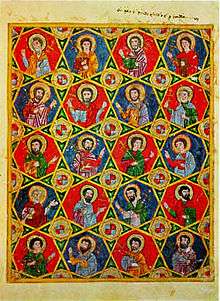
While the Vatican Library has always included Bibles, canon law texts and theological works, it specialized in secular books from the beginning. Its collection of Greek and Latin classics was at the center of the revival of classical culture during the Renaissance age.[7] The oldest documents in the library date back to the first century.[15]
The library was founded primarily as a manuscript library, a fact reflected in the comparatively high ratio of manuscripts to printed works in its collection. Such printed books as have made their way into the collection are intended solely to facilitate the study of the much larger collection of manuscripts.[23]
The collection also includes 330,000 Greek, Roman, and papal coins and medals.[5]
Every year about 6,000 new books are acquired.[5]
The library was enriched by several bequests and acquisitions over the centuries.
In 1623, the hereditary Palatine Library of Heidelberg containing about 3,500 manuscripts was given to the Vatican by Maximilian I, Duke of Bavaria (who had just acquired it as booty in the Thirty Years' War) in thanks for the adroit political maneuvers of Pope Gregory XV that had sustained him in his contests with Protestant candidates for the electoral seat. A token 39 of the Heidelberg manuscripts were sent to Paris in 1797 and were returned to Heidelberg at the Peace of Paris in 1815, and a gift from Pope Pius VII of 852 others was made in 1816 to the University of Heidelberg, including the Codex Manesse. Aside from that, the Palatine Library remains in the Vatican Library to this day.
In 1657, the manuscripts of the Dukes of Urbino were acquired. In 1661, the Greek scholar Leo Allatius was made librarian.
Queen Christina of Sweden's important library (mostly amassed by her generals as booty from Habsburg Prague and German cities during the Thirty Years War) was bought by Pope Alexander VIII on her death in 1689. It represented, for all practical purposes, the entire royal library of Sweden at the time. If it had remained where it was in Stockholm, it would all have been lost in the destruction of the royal palace by fire in 1697.
Among the most famous holdings of the library is the Codex Vaticanus Graecus 1209, the oldest known nearly complete manuscript of the Bible. The Secret History of Procopius was discovered in the library and published in 1623.
Pope Clement XI sent scholars into the Orient to bring back manuscripts, and is generally accepted as the founder of the Oriental section.[6]
A School of library science is associated with the Vatican Library.
In 1959, a Film Library was established.[24] This is not to be confused with the Vatican Film Library, which was established in 1953 at Saint Louis University in St. Louis, Missouri.
The Library has a large collection of texts related to Hinduism, with the oldest editions dating to 1819.[25]
During the library's restoration between 2007 and 2010, all of the 70,000 volumes in the library were tagged with electronic chips to prevent theft.[18]
Manuscripts
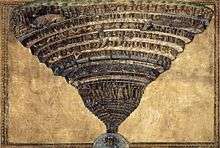
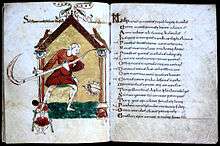
Notable manuscripts in the Library include: Illuminated manuscripts:
Manuscripts relating to Christianity
- Barberini Gospels
- Gelasian Sacramentary, one of the oldest books on Christian liturgy
- Joshua Roll
- Lorsch Gospels, an illuminated gospel book written and illustrated from 778 to 820, which is spread up between various museums. The carved ivory rear cover and the Gospels of Luke and John are kept in the Vatican Library.
- Menologion of Basil II[26]
- Vatican Croatian Prayer Book
- Vergilius Vaticanus
Classic Greek and Latin texts
- Vergilius Romanus, Virgil's Aeneid
- Codex Vaticanus Ottobonianus Latinus 1829, an important 14th-century manuscript of Catullus' poems
- Codex Vaticanus Latinus 3868, a 9th-century facsimile of Terence's comedies[27]
- Parts of Euclid's Elements, most notable Book I, Proposition 47, one of the oldest Greek texts on the Pythagorean Theorem[1]
Alternative
- Codex Borgia, an extensive mesoamerican manuscript that depicts mythology and foundational rituals in the hieroglyphic texts and iconography made of animal skins.
- Codex Vat. Arabo 368, the sole manuscript of the Hadith Bayad wa Riyad, an Arabic love story[28]
- Codex Vaticanus 3738, the Codex Ríos,[29] an accordion folded Italian translation of a Spanish colonial-era manuscript, with copies of the Aztec paintings from the original Codex Telleriano-Remensis, believed to be written by the Dominican friar Ríos in 1566.
- De arte venandi cum avibus, a Latin treatise on falconry in the format of a two-column parchment codex of 111 folios written in the 1240s.
Texts:
- Codex Vaticanus Latinus 3256, four leaves of the Vergilius Augusteus[30]
- Codex Vaticano Rossi 215, fragments of the Rossi Codex[31]
- Codex Vaticanus Graecus 1209, one of the oldest extant Bibles in Greek language
- Libri Carolini
- Vaticanus Graecus 1001, the original manuscript of the Secret History[32]
- One fragment of Heliand and three fragments of the Old Saxon Genesis comprise the Palatinus Latinus 1447.[33]
Digitization projects
In 2012, plans were announced to digitize, in collaboration with the Bodleian Library, a million pages of material from the Vatican Library.
On 20 March 2014, the Holy See announced that NTT Data Corporation and the Library concluded an agreement to digitize approximately 3,000 of the Library's manuscripts within four years.[34] NTT is donating the equipment and technicians, estimated to be worth 18 million Euros.[35] It noted that there is the possibility of subsequently digitizing another 79,000 of the Library's holdings. These will be high-definition images available on the Library's Internet site. Storage for the holdings will be on a three petabyte server provided by EMC.[36] It is expected that the initial phase will take 4 years.[37]
DigiVatLib is the name of the Vatican Library's digital library service. It provides free access to the Vatican Library’s digitized collections of manuscripts and incunabula.[38]
The scanning of documents is impacted by the material used to produce the texts. Books using gold and silver in the illuminations require special scanning equipment.[22] Digital copies are being served using the CIFS protocol, from network-attached storage hardware by Dell EMC.[15]
Gallery of holdings
.jpg) Gospel of Matthew in Persian, the first Persian manuscript to enter the Vatican Library
Gospel of Matthew in Persian, the first Persian manuscript to enter the Vatican Library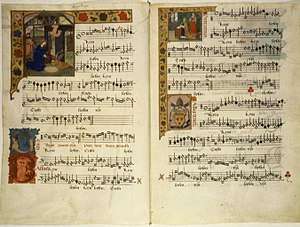 Manuscript page with the five-voice "Kyrie" of the Missa Virgo Parens Christi by Jacques Barbireau
Manuscript page with the five-voice "Kyrie" of the Missa Virgo Parens Christi by Jacques Barbireau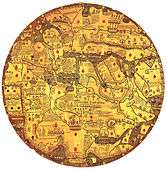 Mappamondo Borgiano, also known as "Tavola di Velletri", consisting of two copper tablets (1430)
Mappamondo Borgiano, also known as "Tavola di Velletri", consisting of two copper tablets (1430)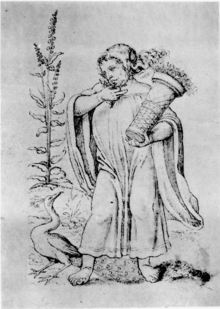 Month of May from in the Chronography of 354 by the 4th century kalligrapher Filocalus
Month of May from in the Chronography of 354 by the 4th century kalligrapher Filocalus%2C_ceiling_fresco_in_the_Camera_dei_Papiri%2C_Vatican_Library%2C_1772_-_M0tty.jpg) Anton Raphael Mengs, The Triumph of History over Time (Allegory of the Museum Clementinum), ceiling fresco in the Camera dei Papiri, Vatican Library
Anton Raphael Mengs, The Triumph of History over Time (Allegory of the Museum Clementinum), ceiling fresco in the Camera dei Papiri, Vatican Library Illumination from the legend of Sain Emerich of Hungary's, c. 1335
Illumination from the legend of Sain Emerich of Hungary's, c. 1335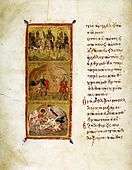 Battle between David and Goliath, Book of Psalms, c. 1059
Battle between David and Goliath, Book of Psalms, c. 1059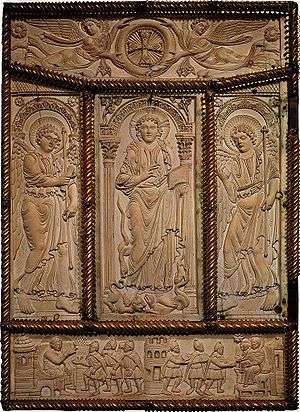 The ivory panels from the back cover of Codex Aureus of Lorsch
The ivory panels from the back cover of Codex Aureus of Lorsch
Related libraries
Vatican Secret Archives
The Vatican Secret Archives, located in Vatican City, is the central archive for all of the acts promulgated by the Holy See, as well as the state papers, correspondence, papal account books,[39] and many other documents which the church has accumulated over the centuries. In the 17th century, under the orders of Pope Paul V, the Secret Archives were separated from the Vatican Library, where scholars had some very limited access to them, and remained absolutely closed to outsiders until 1881, when Pope Leo XIII opened them to researchers, more than a thousand of whom now examine its documents each year.[40]
Vatican Film Library
The Vatican Film Library in St. Louis, Missouri is the only collection, outside the Vatican itself, of microfilms of more than 37,000 works from the Biblioteca Apostolica Vaticana, the Vatican Library in Europe. It is located in the Pius XII Library on the campus of Saint Louis University.[41] The Library was created by Lowrie J. Daly (1914–2000), with funding from the Knights of Columbus.[42] The goal was to make Vatican and other documents more available to researchers in North America.[43]
Microfilming of Vatican manuscripts began in 1951, and according to the Library's website, was the largest microfilming project that had been undertaken up to that date.[44] The Library opened in 1953, and moved to the St. Louis University campus, in the Pius XII Memorial Library, in 1959. The first librarian was Charles J. Ermatinger, who served until 2000. As of 2007, the Library has microfilmed versions of over 37,000 manuscripts, with material in Greek, Latin, Arabic, Hebrew and Ethiopic, as well as several more common Western European languages. There are reproductions of many works from the Biblioteca Palatina and Biblioteca Cicognara at the Vatican, as well as Papal letter registers from the Archivio Segreto Vaticano (Vatican Secret Archives) from the 9th to 16th centuries, in the series Registra Vaticana and Registra Supplicationium.[2]
Staff
The director of the library was made a cardinal and given the title Cardinal Librarian.[6] Individual library staff were called "Custodians".[6] After the reopening of the library in 1883, Pope Leo XIII changed the title to Prefect.[6][45][46]
The library currently has 80 staff who work in five departments: manuscripts and archival collections, printed books/drawings, acquisitions/cataloguing, coin collections/museums and restoration/photography.[5]
List of librarians
(P) Indicates time spent as Pro-Librarian. This is the role of acting librarian, often a librarian who is not a Cardinal.[47]
| Name | Lifetime | Title | Duration as Librarian[48][49] |
|---|---|---|---|
| Marcello Cervini | 1501–1555 | Bibliothecarius I | 24 May 1550–9 April 1555 |
| Roberto de' Nobili | 1541–1559 | Bibliothecarius II | 1555–18 January 1559 |
| Alfonso Carafa | 1540–1565 | Bibliothecarius III | 1559–29 August 1565 |
| Marcantonio da Mula | 1506–1572 | Bibliothecarius IV | 1565–17 March 1572[50] |
| Guglielmo Sirleto | 1514–1585 | Bibliothecarius V | 18 March 1572–16 October 1585 |
| Antonio Carafa | 1538–1591 | Bibliothecarius VI | 16 October 1585–13 January 1591 |
| Marco Antonio Colonna | 1523 ca.–1597 | Bibliothecarius VII | 1591–13 March 1597 |
| Cesare Baronio | 1538–1607 | Bibliothecarius VIII | May 1597–30 June 1607[51] |
| Ludovico de Torres | 1552–1609 | Bibliothecarius IX | 4 July 1607–8 July 1609 |
| Scipione Borghese Caffarelli | 1576–1633 | Bibliothecarius X | 11 June 1609–17 February 1618[52] |
| Scipione Cobelluzzi | 1564–1626 | Bibliothecarius XI | 17 February 1618–29 June 1626 |
| Francesco Barberini | 1597–1679 | Bibliothecarius XII | 1 July 1626–13 December 1633 |
| Antonio Barberini | 1569–1646 | Bibliothecarius XIII | 13 December 1633–11 September 1646 |
| Orazio Giustiniani | 1580–1649 | Bibliothecarius XIV | 25 September 1646–25 July 1649 |
| Luigi Capponi | 1583–1659 | Bibliothecarius XV | 4 August 1649–6 April 1659 |
| Flavio Chigi | 1631–1693 | Bibliothecarius XVI | 21 June 1659–19 September 1681[53] |
| Lorenzo Brancati | 1612–1693 | Bibliothecarius XVII | 19 September 1681–30 November 1693 |
| Girolamo Casanate | 1620–1700 | Bibliothecarius XVIII | 2 December 1693–3 March 1700 |
| Enrico Noris | 1631–1704 | Bibliothecarius XIX | 26 March 1700–23 February 1704 |
| Benedetto Pamphili | 1653–1730 | Bibliothecarius XX | 26 February 1704–22 March 1730 |
| Angelo Maria Querini | 1680–1755 | Bibliothecarius XXI | 4 September 1730–6 January 1755 |
| Domenico Passionei | 1682–1761 | Bibliothecarius XXII | 10 July 1741–12 January 1755(P) 12 January 1755–5 July 1761 |
| Alessandro Albani | 1692–1779 | Bibliothecarius XXIII | 12 August 1761–11 December 1779 |
| Francesco Saverio de Zelada | 1717–1801 | Bibliothecarius XXIV | 15 December 1779–29 December 1801 |
| Luigi Valenti Gonzaga | 1725–1808 | Bibliothecarius XXV | 12 January 1802–29 December 1808 |
| Giulio Maria della Somaglia | 1744–1830 | Bibliothecarius XXVI | 26 January 1827–2 April 1830 |
| Giuseppe Albani | 1750–1834 | Bibliothecarius XXVII | 23 April 1830–3 December 1834 |
| Luigi Lambruschini | 1776–1854 | Bibliothecarius XXVIII | 11 December 1834–27 June 1853 |
| Angelo Mai | 1782–1854 | Bibliothecarius XXIX | 27 June 1853–9 September 1854 |
| Antonio Tosti | 1776–1866 | Bibliothecarius XXX | 13 January 1860–20 March 1866 |
| Jean-Baptiste Pitra | 1812–1889 | Bibliothecarius XXXI | 19 January 1869–9 February 1889[54] |
| Placido Maria Schiaffino | 1829–1889 | Bibliothecarius XXXII | 20 February 1889–23 September 1889 |
| Alfonso Capecelatro | 1824–1912 | Bibliothecarius XXXIII | 29 August 1890–14 November 1912[55] |
| Mariano Rampolla del Tindaro | 1843–1913 | Bibliothecarius XXXIV | 26 November 1912–16 December 1913 |
| Francesco di Paola Cassetta | 1841–1919 | Bibliothecarius XXXV | 3 January 1914–23 March 1919 |
| Aidan [Francis Neil] Gasquet | 1845–1929 | Bibliothecarius XXXVI | 9 May 1919–5 April 1929 |
| Franz Ehrle | 1845–1934 | Bibliothecarius XXXVII | 17 April 1929–31 March 1934 |
| Giovanni Mercati | 1866–1957 | Bibliothecarius XXXVIII | 18 June 1936–23 August 1957 |
| Eugène Tisserant | 1884–1972 | Bibliothecarius XXXIX | 14 September 1957–27 March 1971 |
| Antonio Samoré | 1905–1983 | Bibliothecarius XL | 25 January 1974–3 February 1983 |
| Alfons Maria Stickler | 1910–2007 | Bibliothecarius XLI | 7 September 1983–27 May 1985(P) 27 May 1985–1 July 1988 |
| Antonio María Javierre Ortas | 1921–2007 | Bibliothecarius XLII | 1 July 1988–24 January 1992 |
| Luigi Poggi | 1917-2010[56] | Bibliothecarius XLIII | 9 April 1992–29 November 1994(P) 29 November 1994–25 November 1997 |
| Jorge María Mejía | 1923-2014 | Bibliothecarius XLIV | 7 March 1998–24 November 2003 |
| Jean-Louis Tauran | 1943-2018 | Bibliothecarius XLV | 24 November 2003–25 June 2007 |
| Raffaele Farina | 1933- | Bibliothecarius XLVI | 25 June 2007–9 June 2012 |
| Jean-Louis Bruguès | 1943- | Bibliothecarius XLVII | 26 June 2012–1 September 2018 |
| José Tolentino Mendonça | 1965- | Bibliothecarius XLVIII | 1 September 2018- |
See also
- Index of Vatican City-related articles
- The Vatican Splendors
- Vatican Secret Archives
- Vatican Film Library
- Archive of the Congregation for the Doctrine of the Faith
Notes
- This sculpture is described in the following words: "S. Tommaso seduto, nella sinistra tiene il libro della Summa theologica, mentre stende la destra in atto di proteggere la scienza cristiana. Quindi non siede sulla cattedra di dottore, ma sul trono di sovrano protettore; stende il braccio a rassicurare, non a dimostrare. Ha in testa il dottorale berretto, e conservando il suo tipo tradizionale, rivela nel volto e nell'atteggiamento l'uomo profondamente dotto. L'autore non ha avuto da ispirarsi in altr'opera che esistesse sul soggetto, quindi ha dovuto, può dirsi, creare questo tipo, ed è riuscito originale e felice nella sua creazione."[19]
References
- Mendelsohn, Daniel (3 January 2011). "God's Librarians". The New Yorker. 86 (42). p. 24. ISSN 0028-792X. Retrieved 3 August 2014.
- Vatican Film Library informational pamphlet
- Strayer, Joseph, ed. (1989). Dictionary of the Middle Ages. Scribner. ISBN 0684190737.
- Wiegand, Wayne A.; Davis, Donald G., eds. (1994). Encyclopedia of Library History. New York: Garland. p. 653. ISBN 0824057872.
- Bloom, Ocker. "The Vatican Library and its History". Ibiblio. Retrieved 1 August 2014.
- Meert, Deborah. "A History of the Vatican Library". capping.slis.ualberta.ca. University of Alberta. Retrieved 31 July 2014.
- "The Library of Congress: Rome Reborn: The Vatican Library & Renaissance Culture - The Vatican Library - The City Reborn: How the City Came Back to Life". Retrieved 2 August 2014.
- Clark, John Willis (1899). On the Vatican Library of Sixtus IV.
- Giacomo Castrucci (1856). "Tesoro letterario di Ercolano, ossia, La reale officina dei papiri ercolanesi".
- "Herculaneum Papyri in the National Library in Naples". The Phraser. 2015.
- HONAN, WILLIAM H. (30 May 1995). "Teacher Tied to Stolen Manuscript Pages Faced Prior Ethics Questions, Colleagues Say". The New York Times. Retrieved 1 August 2014.
- MONTALBANO, WILLIAM D. (25 May 1995). "U.S. Scholar Suspected in Theft of Manuscript Pages". Los Angeles Times. Retrieved 1 August 2014.
- "Vatican Apostolic Library". Vaticanstate.va. Retrieved 28 July 2014.
- The Pope’s Visit to the Vatican Library 19 December 2010 In: L'Osservatore Romano. Retrieved 2 August 2014
- Del Nibletto, Paolo. "The Vatican Library CIO's sacred mission: To digitize everything". itworldcanada.com. IT World Canada. Retrieved 28 July 2014.
- Willey, David (17 July 2007). "Vatican Library closure irks scholars". BBC News. Retrieved 17 July 2007.
- "Vatican Library Homepage". Retrieved 13 September 2010.
- Winfield, Nicole (15 November 2010). "Vatican library reopens after 3-year restoration". NBC News. Retrieved 28 July 2014.
- Hendrix, John (2003). History and culture in Italy. University Press of America. ISBN 9780761826286. Retrieved 9 September 2012.
- Vaticana, Biblioteca Apostolica (1893). Nel giubileo episcopale di Leone XIII. omaggio della Biblioteca vaticana XIX febbraio anno MDCCCXCIII. Retrieved 9 September 2012.
- "The Library of Congress: Rome Reborn: The Vatican Library & Renaissance Culture - The Vatican Library - A Library Takes Shape: Books, Benches, and Borrowers". Retrieved 2 August 2014.
- Taylor, Lesley Ciarula (2 May 2013). "Digitizing history: 82,000-manuscript collection Vatican Library goes online". Toronto Star. Retrieved 28 July 2014.
- "The Vatican Palace, as a Scientific Institute". Catholic Encyclopedia. New Advent. Retrieved 2 August 2014.
- "Statute of the Vatican Film Library". vatican.va. Retrieved 28 July 2014.
- "Vatican Library carries extensive collection of ancient Hindu scriptures". eurasia review. 29 June 2014. Archived from the original on 28 July 2014. Retrieved 28 July 2014.
- John W. Wohlfarth (1 September 2001). Elysium. AuthorHouse. p. 128. ISBN 978-0-7596-5406-8.
- C. R. Dodwell (2000). Anglo-Saxon Gestures and the Roman Stage. Cambridge University Press. p. 3. ISBN 978-0-521-66188-1.
- D’Ottone, Arianna (2010). "Il manoscritto Vaticano arabo 368: Hadith Bayad wa Riyad. Il codice, il testo, le immagini". Rivista di Storia della Miniatura (in Italian). Centro Di. 14: 55. Retrieved 25 July 2014.
- "FAMSI - Akademische Druck - u. Verlagsanstalt - Graz - Codex Vaticanus 3738". Akademische Druck - u. Verlagsanstalt - Graz CODICES. FAMSI. Retrieved 29 July 2014.
- Vergilius Augusteus : vollst. Faks.-Ausg. im Originalformat : Codex Vaticanus Latinus 3256 d. Biblioteca apostolica vaticana u. Codex Latinus fol. 416 d. Staatsbibliothek Preussischer Kulturbesitz. Catalog - UW-Madison Libraries. University of Wisconsin Madison Libraries. 1976. Retrieved 29 July 2014.
- Christopher Kleinhenz (8 January 2004). Medieval Italy: An Encyclopedia. Routledge. p. 136. ISBN 978-1-135-94880-1.
- Charney, Noah (16 November 2011). "Vatican Mysteries: What's So Secret about Procopius' "Secret History?"". Blouinartinfo. Louise Blouin Media. Archived from the original on 22 February 2014. Retrieved 28 July 2014.
- John M. Jeep (2001). Medieval Germany: An Encyclopedia. Psychology Press. p. 57. ISBN 978-0-8240-7644-3.
- McKenna, Josephine (20 March 2014). "Vatican library plans to digitise 82,000 of its most valuable manuscripts". The Daily Telegraph. Archived from the original on 24 March 2014. Retrieved 23 March 2014.
- Denti, Antonio (20 March 2014). "Vatican library will digitize its archives and put them online". Reuters. Retrieved 28 July 2014.
- Greiner, Lynn (23 July 2014). "Storage giant EMC looks to ease concerns about Flash technology". Financial Post.com. Retrieved 28 July 2014.
- Denti, Antonio (20 March 2014). "Vatican library will digitize its archives and put them online". Reuters. Retrieved 1 August 2014.
- "DigiVatLib". digi.vatlib.it. Retrieved 17 January 2017.
- von Pastor, Ludwig Freiherr (1906). The History of the Popes: From the Close of the Middle Ages. Drawn from the Secret Archives of the Vatican and Other Original Sources, Volume 3. Trübner & Company Ltd. p. 31. Retrieved 28 July 2014.
papal account books.
- "Table of Admittances to the Vatican Secret Archives in the Last Years". Archived from the original on 6 May 2011.
- "Knights of Columbus Vatican Film Library - Home Page". slu.edu. Retrieved 13 November 2007.
- "LOWRIE J. DALY, S.J., MEMORIAL LECTURE ON MANUSCRIPT STUDIES". Libraries at Saint Louis University. Saint Louis University. Archived from the original on 30 July 2014. Retrieved 29 July 2014.
- C. Krohn, Ernst (June 1957). "Notes Second Series, Vol. 14, No. 3". Notes. Music Library Association. 14 (3): 317–324. doi:10.2307/891821. JSTOR 891821.
- "Kentucky New Era - Aug 14, 1954". Kentucky New Era. 14 August 1954. Retrieved 30 July 2014.
- "Government | Sito ufficiale dell'Archivio Segreto Vaticano – Città del Vaticano". Archiviosegretovaticano.va. Archived from the original on 8 January 2014. Retrieved 7 October 2013.
- "BAV - Biblioteca Apostolica Vaticana". Vaticanlibrary.va. Retrieved 7 October 2013.
- Guruge, Anura. "Replacement For Cardinal Farina As The Archivist; Cardinal Antonelli's Replacement, Vincenzo Paglia, Immediately A Cardinalabili". Popes and Papacy. Retrieved 2 August 2014.
- "Vatican Library History". Vaticanlibrary.va. Retrieved 7 October 2013.
- "Vatican Apostolic Library - Institute Connected with the Holy See". GCatholic.org. Retrieved 7 October 2013.
- "Cardinals of the Holy Roman Church - Consistory of February 26, 1561 (II)". 5 August 2006. Retrieved 10 July 2013.
- "Cardinals of the Holy Roman Church - Consistory of September June 5, 1596 (II)". 15 April 2007. Retrieved 7 October 2013.
- "Cardinals of the Holy Roman Church - Consistory of July 18, 1605 (I)". Archived from the original on 23 May 2017. Retrieved 7 October 2013.
- "Cardinals of the Holy Roman Church - Consistory of April 9, 1657 (I)". Retrieved 7 October 2013.
- "Cardinals of the Holy Roman Church - Consistory of March 16, 1863 (XIII)". Retrieved 7 October 2013.
- "Cardinals of the Holy Roman Church - Consistory of July 27, 1885 (VIII)". Retrieved 7 October 2013.
- "Cardinals of the Holy Roman Church - Luigi Poggi". Retrieved 7 October 2013.
Works cited
- Cardinals of the Holy Roman Church - Miranda, Salvador. "The Cardinals of the Holy Roman Church". Florida International University Libraries.
Further reading
- Rome Reborn: The Vatican Library & Renaissance Culture, an online exhibition from the Library of Congress.
- Vatican to digitize Apostolic Library of 1.6 million volumes for general perusal, PCWorld.com, 29 October 2002. A joint effort between the Vatican and Hewlett-Packard.
External links
| Wikimedia Commons has media related to Biblioteca Apostolica Vaticana. |
- Official website
- Vatican Library old home page, with online catalog search
- History of the Vatican Library, from the Library's site
- Treasures of the Vatican Library Exposed via The European Library
- Toward On-line, worldwide access to Vatican Library materials (1996). A collaborative effort (pioneered by Fr. Leonard Boyle OP Prefect of the Vatican Library) between the Vatican Library and IBM, the primary goal of which is to "provide access via the Internet to some of the Library's most valuable manuscripts, printed books, and other sources to a scholarly community around the world."
- Knights of Columbus Vatican Film Library. Saint Louis University library that focuses on the collection of the Vatican Library.
- The Secret History of Art by Noah Charney on the Vatican Library and Procopius. An article by art historian Noah Charney about the Vatican Library and its famous manuscript, Historia Arcana by Procopius.
- The Vatican: spirit and art of Christian Rome, a book from The Metropolitan Museum of Art Libraries (fully available online as PDF), which contains material on the library (p. 280-290)
